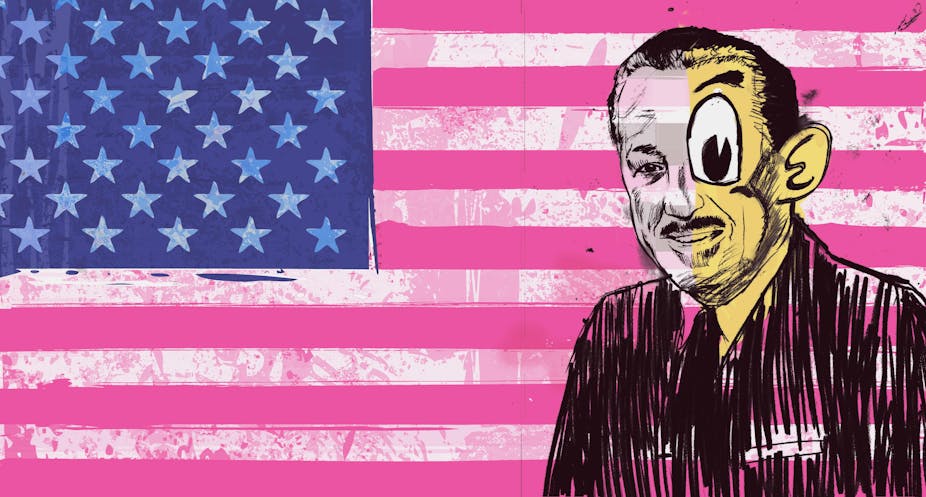The Brisbane Festival’s production of Philip Glass’s opera The Perfect American is only the third production of the 2012 work ever to be staged. That’s quite a coup for the Brisbane Festival and Opera Queensland.
The Perfect American was commissioned by Madrid’s Teatro Real and London’s English National Opera to mark the American composer’s 75th birthday. Glass’s telling of the Disney myth focuses on the final stages of Walt Disney’s life and career – a high art critique of a popular culture icon.
The festival’s pre-performance introduction set the tone; there was reference to da Vinci and “the Masters” – a move that locates Glass in a genealogy of high-culture European mastery. Audio clips of Glass’s previous work triggered spontaneous conducting in the guest speaker. Culture with a capital C, Art with a capital A.
Glass is a prolific composer, known more widely for his cinematic scores than his experimental music. There are several musical motifs within the opera’s score that are recurrent in Glass’s often sparse work. This score is more lush and almost romantic than most of his work, often mirroring aspects of the heavily orchestrated scores of Disney movies.
Ultimately, it is Dan Potra’s set design that steals the show. The emblematic elemental line sketches of the incremental creative process of animation are projected onto multiple mobile screens operated by visible rigs and pulleys, keeping the stage in motion throughout.
A circular platform at the centre of the stage, which most frequently houses Disney’s hospital bed, is turned throughout the performance mostly to signal a shift in scene.
Similarly, Leo Warner’s video design provides depth and texture to the at times plodding libretto. Animated line drawings map out the terrain of Disney’s magical kingdom – a mythical, middle America epitomised by Disney’s hometown of Marceline. Main St, USA is conflated with innocence, authenticity and hardworking values, obscuring the ugly politics that underscore the realities of the Disney empire.
The Disney genius
The concept of genius is deployed within the libretto through Disney’s own narcissistic proclamations and in the discourse surrounding the production itself.
Disney’s narcissism, megalomania and obsession with his legacy are repeatedly emphasised. The cult of self is easily mapped onto Andy Warhol, whose somewhat incongruent appearance in the storyline serves as a metaphor for both the unattributed creative labour at the centre of Disney’s (and Warhol’s) work and the unbridled celebration of the myths of American meritocracy and cultural colonisation.
Seemingly, Warhol’s superficiality is employed as a foil to Disney’s own embrace of beautiful lies. Warhol’s statement “I never criticise America and I never show ugliness in my work”, and his comment to Disney that “we are one and the same” makes sure that we understand that. Even so, Warhol’s ridiculously camp caricature is much too asinine to add anything to the story.
Just as Warhol sees himself in Disney, Disney sees himself in Abraham Lincoln.
Lincoln and Disney’s shared meagre rural beginnings are the stuff of American dreams. But their ideas diverge through their understanding of equality and opportunity.
One of the more memorable moments showcasing Disney’s bigotry is in his exchange with a malfunctioning, robotic Lincoln. Disney equates civil rights with communism and the fight for equality as a perversion of the founding fathers’ hopes for the country.
Robot Lincoln correlates with the process line of Disney animators employed to realise Disney’s creative vision. Coalesced by their harried postures and plaid outfits, at various times the workers take on black sleeves and white gloves (Mickey Mouse) and rabbit heads (Bugs Bunny) to denote dream sequences. But these aren’t the stuff of Disney’s dreams. These rabbits are more Donnie Darko than Bugs.
The aspiration central to the myth of the American Dream is realised in Disney’s iconic status as dream maker.
Disney imagined Disneyland as a magical kingdom with him as the king but like every fantasy, underneath the magic is a web of myths and manipulations. Disney, or Walt as he prefers to be called, doesn’t do the drawing, he is the “storyteller” – “a child…[who] looks at the world in wonder”.
The stories he tells are of a mythological America, one that is distinctly white and centred simultaneously on unending aspiration and small-town experiences and values. Disney’s mistreatment of his workers mirrors the political sentiment that there is always suffering to realise a grand vision. Snow White alone required the labour of 500 workers – most of whom signed away their rights of attribution.
Dantine, the exploited but resistant worker, takes on the appearance of a cartoon character as his frustration mounts. His rotund figure stuffed with sheaves of drawings that are slowly shed as he makes his final exit. In one of the more energetic scenes, Disney claims that Dantine’s “unpatriotic idiotic left wing remarks insult everything Disney stands for” to which the worker replies, “You were never an artist. All you were was a moderately successful CEO”.
The focus on creative labour and intellectual property throughout this work is timely. The musical motif that starts of sounding like trains slowly shifts to sound like the old ticker machines of the pre-digital stock market. This underscores the entrepreneurial fervour of Disney, particularly as his endeavour to colonise the world with his brand and his values is central theme of the production.
Trains are a recurrent motif in the opera. Trains symbolise progress and mobility and were central to the expansion of America’s new world. For Disney, trains inspired his vision of an amusement park. In one scene, the process line of Disney animators becomes a train across the front of the stage.
Behind all the dreams and wonder, the workers were the engine that drove the Disney machine. Without any irony, The Perfect American debunks Disney’s mythology – and simultaneously reinforces that of Philip Glass.

